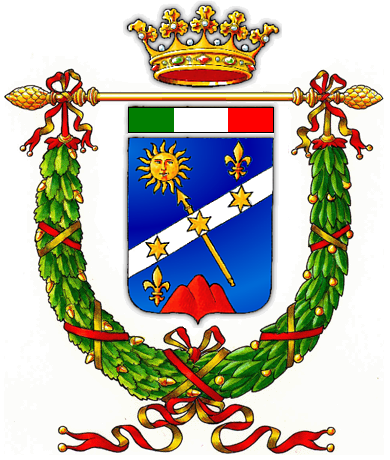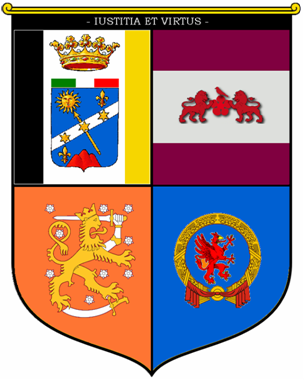Difference between revisions of "Nasuti"
(→Government) |
(→Justice) |
||
| Line 165: | Line 165: | ||
'''The Gathering for the Law of the Laymen''' is the civil for the justice. Is chief is the Distinguished Prince Raffaele I, chosen by the Prince. | '''The Gathering for the Law of the Laymen''' is the civil for the justice. Is chief is the Distinguished Prince Raffaele I, chosen by the Prince. | ||
| + | |||
| + | ===Coats of arms of the Establishment=== | ||
{| border="1" cellpadding="1" | {| border="1" cellpadding="1" | ||
| − | |||
|- | |- | ||
|[[image:Nasuti-principe.PNG|thumb|center|100px|His Catholic Majesty Prince]] | |[[image:Nasuti-principe.PNG|thumb|center|100px|His Catholic Majesty Prince]] | ||
Revision as of 13:11, 26 May 2007

| |
| Flag of Nasuti | |
| Motto: Appicce lu compiuter. | |
| File:Nasutimap.jpg MAP | |
| Region | Catholic |
|---|---|
| Capital | Stronghold of Nasuti |
| Official Language(s) | Italian, Lancianese |
| Leader | His Catholic Majesty Prince Cris I |
| Population | 622 milion |
| Currency | Lira del Camerlengo |
| NS Sunset XML | |
Contents
Principato Romano Cattolico di Nasuti
Principato Romano Cattolico di Nasuti (The Roman Catholic Princedom of Nasuti) is a Nation of the region Catholic, member of UN, member of Catholic Council and signer of the Catholic Charter. The capital city is Stronghold of Nasuti, a town built around to a medieval fortress. The Roman Catholic Princedom of Nasuti refer itself whit short form Nasuti.
The official language of the Nasuti is Italian, but a lot citizen speak (not exist a reference text for coding the writing) an ancient language called "Lancianese" native of the ancient domination that the Princedom was submitted.
Nation's adjectival form is Nasutian (Nasutere in Lancianese) and and it is the same for noun for persons from this nation.
The population is of about 600 millions, but the continuous growth carries the analysts to indicate the achievement of 1 billion within the end of the year 2007.
Major ethnic groups is Italic Nasutian (95%), German (2%), English (2%), French (0.5%) and Polish (0.5%).
The Holy Flag of the Principato Romano Cattolico di Nasuti is, from left to right, black, white and yellow, with the coat of arms of the Sovereign Royal Family on the white cloth.
Story of Nasuti and of Sovereign Royal Family
From foundation to Lancianese Domination
The ancient name of the Nasuti first village is Castra Samnium, a roman colony that became Municipium in 132 b.C. with the name of Anxianum and and it had this status until the barbaric invasions.; Samnium Region became the name of the region under the controll of Anxianum.
In the medieval age in all of the Samnium Region came built some outposts fortified, particularly the most large it was the Fortress of the Samnium in the Anxianum.
Samnium Region expanded themselves until to occupy almost all of the current area (with the annexation of the territories of Rizzacorno, Riegne, and Feltrin), becoming a regional power managed from noble faithful to the Holy Roman Empire. During the conflict between Pope and the Empire, although the noble are lined up with the Emperor, the people rhymed faithful to the Pope.
After hunted it of the "unfaithful noble", the greater city of the Samnium Region (Anxano Sannita - the medieval name of Anxianum -, Castle Frentan, Teate, Solomona, Villa Ripa) decided to unite itself in a commercial and politic league that give a reasonable independence from the close powers, unitll the war against the Duchy of Lanciane, that invaded all the Samnium Region and subjected it until the 18th century.
The Rebellion an the Kingdom
In 1715 the rebellion carried to the independence of the community and subsequently the Council of Sages and Braves, that managed the community, decided to entrust the government to the family of the most courageous one of the commanders, Ferdinando Domenico Nasuti.
The first one governing was Nicola I the Great, grandchild of Ferdinando Domenico, crowned King of Samnium in 1780. Nicola I, admirer of the struggle for the independence of the USA and of their constitutional democracy, basins the first Constitution that established the power of the King and the power of the Council of Sages and Braves. He fixed the capital in the town of Stronghold of Anxano (new name of Anxano Sannita) and he consolidated, with an agreement and oath both valid for all of the its sovereigns successors, the absolute relations of faithfulness to the Pope and to the Roman Catholic Church.
During the kingdom of Ferdinando I the Charitable and Gildo I the Just, the trouble of death was progressively abolished and was founded the Gathering for the Law of the Laymen for the management of the justice.
In 1890 King Gildo III the Reformer decided to substitute the Council of Sages and Braves with the Senate of the Faithful and reform the state establishing the present type of government (with the division of the power betweeen the King, the Senate of the Faithful and the Gathering for the Law of the Laymen); the last session of the Council of Sages and Braves decided to change the name of the Kingdom with the name of sovereign family: the Kingdom of Samnium became the Constitutional Monarchy of Nasuti. The Kingdom did not participate to the World Wars I.
In 1930, for the 150th anniversary of the coronation of Nicola I the Great and of the kingdom of the Nasuti, King Domenico I and the Senate of the Faithful approved the change of the name of the capital in Stronghold of Nasuti.
King Domenico II the Peaceful guaranteed the neutrality of the kingdom during World Wars II and the neighboring indipendent regions of Gaeta and Costs of Teate asked of to be annas to the kingdom.
King Raffaele I and his son Nicola II inaugurated the season of the "short and modern kingdom": both after little years of kingdom have abdicated in favor of the sons.
After the abdication of King Nicola II, the King Cris I announced a referendum that changed the Constitutional Monarchy to Princedom, taking again in part the ancient title of "Roman Catholic". The Pricnipe Cris I has wanted the presence of its two enlightened predecessors to its flank in the government of the Princedom.
Chronology of the sovereign family
| King | born | crowned | dead |
|---|---|---|---|
| Ferdinando Domenico Nasuti (not King, one of the commanders of the rebellion), | 1682 | 1745 | |
| Domenico Nasuti (not King, Member of Council of Sages and Braves) | 1712 | 1761 | |
| Nicola I the Great, 1st King | 1735 | 1780 | 1790 |
| Ferdinando I the Charitable | 1760 | 1790 | 1833 |
| Gildo I the Just | 1792 | 1833 | 1856 |
| Gildo II the Elder | 1818 | 1856, abdicated in 1887 | 1898 |
| Gildo III the Reformer | 1847 | 1887 | 1921 |
| Domenico I | 1873 | 1921 | 1925 |
| Domenico II the Peaceful | 1902 | 1925 | 1964 |
| Raffaele I | 1924 | 1965, abdicated in 1979 | |
| Nicola II | 1955 | 1979, abdicated in 2004 | |
| Cris I | 1980 | 2004, became 1st Prince in 2007 |
Government
Executive
Nasuti is a Constitutional Princedom with separation of powers: legislative to the Senate of the Faithful; executive to the hereditary Prince (with title of "His Catholic Majesty Prince"); justice to the Gathering for the Law of the Laymen.
Head of State and of Government is His Catholic Majesty Prince Cris I and his vice is Bishop or Cardinal of the Frentan diocese named from the Pope. A part of the executive is chosen personally from the Prince, while remaining is named according to the result of the votes.
Ministers and Advisors:
- Minister of the Insides and of the Defence: Distinguished Prince Nicola II, chosen by the Prince;
- Advisors of the Prince for the Foreign Relationship: Duke Aldo and Dukess Patricia of Gaeta, chosen by the Prince; the Prince treats personally the diplomatic relationship with the foreign countries;
- Minister of the Treasury: Countess Sara of Castle Frentan, elected;
- Minister for the Free Information: Countess Azzurra of Feltrin, elected;
- Minister for the Science, Technology, Reserch and Development: Countess Faby of Riegne;
- Chief of the Integrated Catholic Educational System: Bishop or Cardinal of the Frentan diocese;
Legislative
The Senate of the Faithful is composed from 50 elected Senators and maximum 10 Senators to life named from the Prince. Can become Senators all of the pratice catholic citizens than have more of 30 years and that lend public profession of faith.
The Senate proposes, discusses and approves the ordinary laws. The constitution can be changed only with the authorization of the Prince.
Justice
The Gathering for the Law of the Laymen is the civil for the justice. Is chief is the Distinguished Prince Raffaele I, chosen by the Prince.
Coats of arms of the Establishment
Nasuti administrative division
[[image:Nasutiregion.jpg|thumb|400px][REGION MAP]
The Princedom is divided in 12 Regions, with a limited local autonomy, derived from the ancient territories of the Samnium Region:
1. Samnium Region, with the capital town Stronghold of Nasuti
2. Castle Frentan
3. Teate
4. Solomona
5. Villa Ripa
6. County of Feltrin
7. County of Riegne
8. Earldom of Rizzacorno
9. Valley of Carmelo
10. Duchy of Lanciane
11. Duchy of Gaeta
12. Costs of Teate
Religion
The religion is a fundamental appearance of the life of the state and of the citizens. The Official State Religion is Roman Catholic (professed by 99% of citizens): Nasuti is a nation of Christians loyal to the traditions of the Roman Catholic Church and obedient to Supreme Pontiff Pope Benedict XVI. The Nasutian are faithful to the moral and to the teachings of Jesus Christ and of His Church.
Other Religions is professed by 1% and to them is guaranteed the freedom of religion and the independence from Catholic Church authority with special law.
Military
Supreme Commandant chief of the Military Forces is William Adama, chosen from Prince Nicola II when it governed and maintained in service from Prince Cristian I for military merits. the Supreme Commandant has a partial autonomy but obeys directly to the Prince. The Military Forces of the Princedom is composed from:
- 10 Army legion, I-X Legio: Leo, Ursus, Lupus, Taurus, Bison, Elephantus, Aspis, Tigris, Panthera, Equus;
- 10 Marine Legion, XI-XX Legio: Selachi, Fulguru, Manta, Sphyraenida, Delphinus, Octopus, Nautilus, Medusa, Caronte, Nemo;
- 10 Aviation and Aerospace legion, XXI - XXX Legio: Aquila, Accipiter, Milvus, Bubo, Draco, Vultur, Corvus, Merula, Enterprise, Von Braun.
Each legion is led by 1 General (Army) or Admiral (Marine) or Air Marshal (A&A) assisted by a number of junior officers and is divided into 10 Cohortes. Each Cohort is led by 1 Major or Lieutenant assisted by a number of junior officers consisting of 100 Centuries. Each Century consisting 50, 100 or 200 men and is led by a Centurio, assisted by a number of junior officers. Individual soldiers were referred to as: Milites (Army), Marines (Marine) or Air Legionarii (Aviation and Aerospace).
Every citizen after 20th birthday is submitted annually to a period of 20 days of training that give back it in the "Reserve Corps for the Defence of the Homeland.”
The Constitution and the moral of Nasuti expects the use of the Military Forces only for defend the Nation and its allies, but refuses the use of the force like tool of aggression and submission.
Civil Life
School
In Nasuti the education entrusted by the Integrated Catholic Educational System:
- obligatory Jesuit school from 5 to 18 year; - Catholic University;
For not Catholic there is voluntary abstention from some disciplines, to replace with other choices from the Gathering for the Law of the Laymen.











